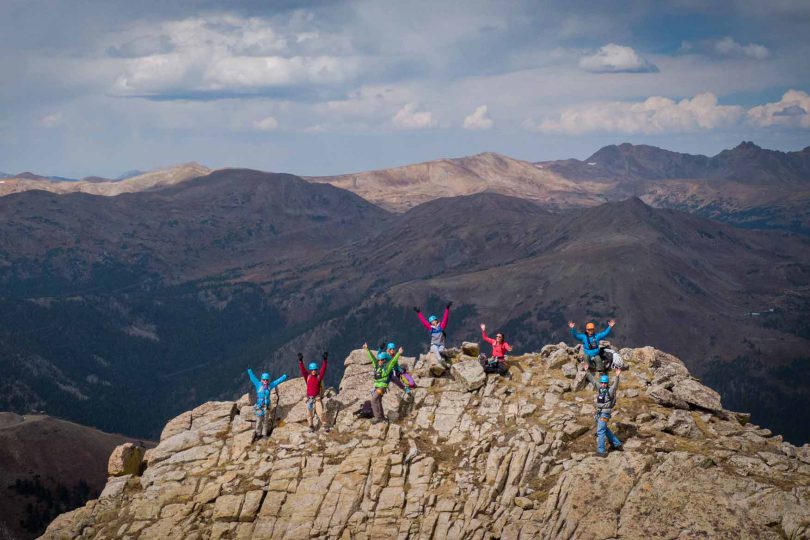By Joanne Palmer –
On a sunny morning in late March, I find myself flattened against a granite rock slab at the Royal Gorge, wondering what to do next. I need to go up, to advance toward the summit but I am frozen in fear. One foot is on a rung, one hand is on steel cable, but to get to the next point requires finding a natural hand and foothold on the relentless rock.
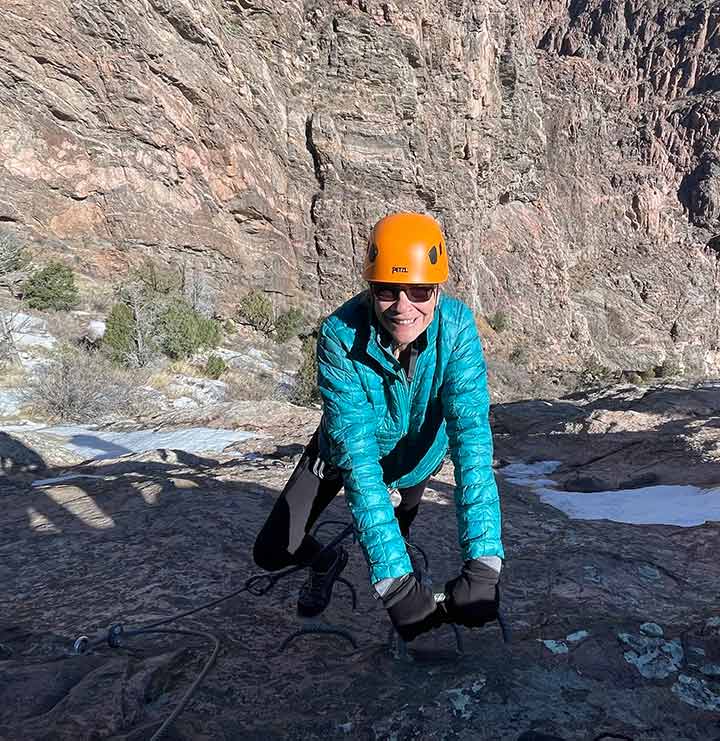
Let me be clear: I am not a rock climber. I hike, bike and play pickleball—all sports that are on or close to the ground and afford the opportunity to quit and go home at any time.
But now I must move, I must climb, I must live up to the magnet on my refrigerator door that states, “Do one thing every day that scares you.” Done and done.
< Writer Joanne Palmer makes her way up the path.
And on I go.
Below is my partner, Evan, who has valiantly agreed to accompany me on this adventure. Above, Marquette, our guide. Marquette is the best. He has given us detailed instructions: clip in here, put a foot there, grasp a handhold. It looked easy, like a dance step. But now I struggle to follow his lead.
I refuse to look behind me as I already know what is there: a steep, unforgiving drop. My Spidey senses are tingling, my heart is thudding and the phrase “Get a grip” takes on new meaning.
Birds are singing, but their song is drowned out by my incessant self-talk. “You’re too old,” “You’re gonna fall,” and the loudest of all, “Why aren’t you home in your recliner, watching ‘Jeopardy?’”
This is the Via Ferrata.
The Via Ferrata literally means Iron Way or Iron Path in Italian. In English, I loosely translate it to mean, “Crazy things I thought I could do while sitting in my living room.” The origins of the Via (refer to it this way if you want to sound cool) are in fact, very cool.
It was the ingenious solution to the improbable task of transporting equipment and soldiers through the Alps during World War I. These enterprising, hard-working soldiers hammered steel cables, rungs and ladders into the rocks, creating a stairway of sorts through the Alps.
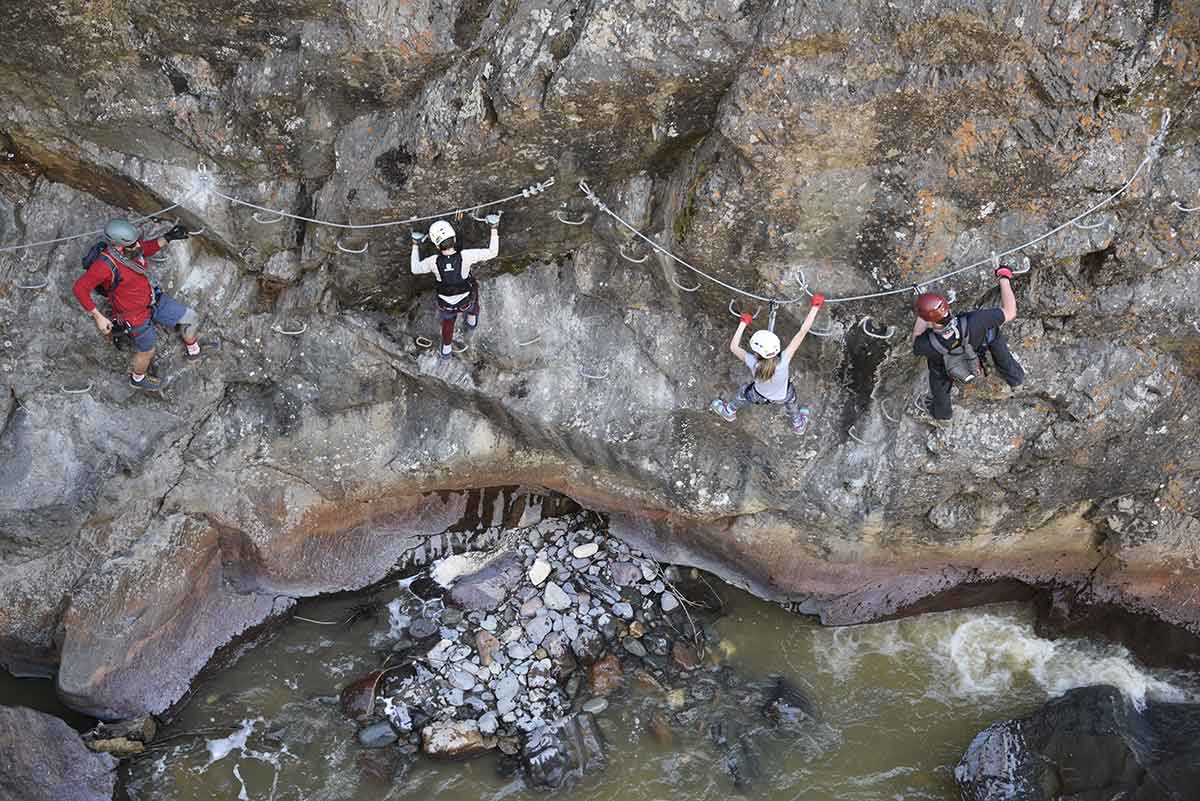
Ages 12 and older can make their way along the iron path with the help of a guide. Photo courtesy of Ouray Via Ferrato. >
Long popular in Europe, the Via Ferrata is relatively new to Colorado and quickly gaining popularity as the state’s newest adrenaline-fueled sport. As Mark Iuppenlatz, owner/director of San Juan Mountain Guides, puts it, “In Ouray, we hit our four-year goal in the first year. It allows people to experience rock climbing safely without having technical ability.”
Although there are seven Via Ferratas in Colorado, only one is open year round, which is how we find ourselves in Cañon City at the Royal Gorge.
“You’re doing great,” Marquette calls encouragingly. Yeah, right. Rock is momentarily a four-letter word in my vocabulary.
“It’s easier if you get vertical. You can lean back and walk right up the rock.”
Uh-huh. So not happening. My derring-do has been reduced to just, “DO.”
Marquette is right, of course. We have what it takes to do it. The issue is not the equipment. We have been outfitted with sticky-soled shoes that help provide traction on the rock. The climbing harness has not one but two carabiners with lanyards that attach, leash like, to a steel cable. The issue is trust. Trust the equipment. Trust the guide.
Get a grip.
I find a foothold. Deep breath. I find a handhold. Deep breath. I hug the rock… and slowly inch up.
It’s been a long time since I’ve challenged myself. It’s been an even longer time since I’ve done anything outside my comfort zone. The pandemic has offered a perfect excuse to stay put, walk the dog, not clean my closet and aspire to be the next Jeopardy champion. I can hear Ken Jennings now, “What is (dramatic pause) an age-appropriate pastime for a woman in her late 60s with a new knee?” The correct answer? Bingo!
With my face inches away from the rock slab, I ignore the negative chattering and focus on the process. Using one hand, I open the gate of the carabiner and clip on the metal climbing rope. Open, clip, repeat. Open, clip, repeat. The sun glints off the metal and I continue to move cautiously up.
Unlike other sports, the Via Ferrata is both psychologically and physically challenging. It somehow shines an unforgiving light on all fears, both real and imagined. As Todd Rutledge, co-owner of Mountain Trip in Telluride, puts it, “It is regularly an emotional journey as it is categorically different from anything else in life.”
After completing the Ouray Via Ferrata, retired school counselor Lou Hart, 67, of Ouray concurs. “I was telling myself, ‘I can do this,’ the whole way through. At the end, I was so elated I was crying — it was such a feeling of accomplishment.”
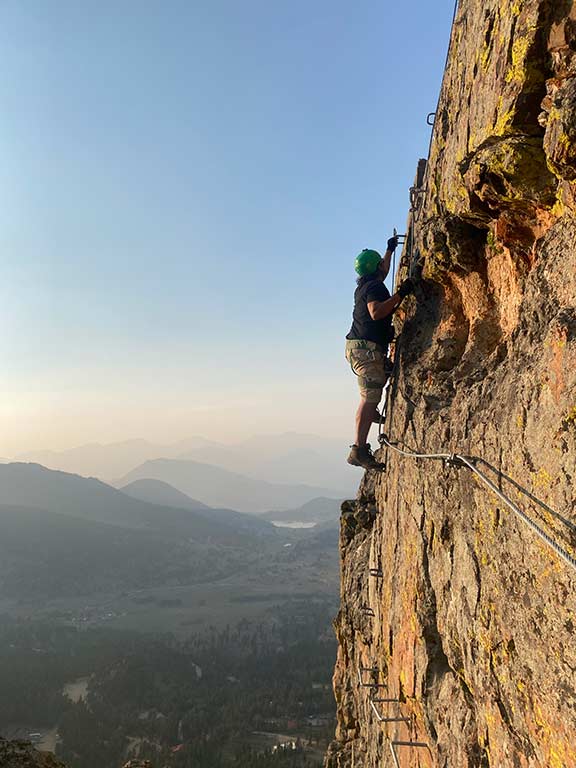
Dawn Glanc, head ranger of the Ouray Via Ferrata, says “It’s cool to see people go from being terrified to so confident that they come back to do it with their friends.”
Marquette calls encouragingly, “You’re almost at the top.” Click, clack. I focus on the sound of the carabiners snapping on and off the cable.
Click, clack. I keep my head down and concentrate only on the next step, not the summit. This singular focus helps ease my worries and soon I am standing next to Marquette at the top.
Marquette reassures me my fears are normal: “The Via Ferrata challenges you to conquer all that scares you. It is about conquering fears, fear of heights, fear of trying something new and fear of falling, and then finding the courage to do it anyway.”
Roger that!
At the summit, an “oh wow” moment awaits. Mother Nature has outdone herself. Almost 1,000 feet below, the mighty Arkansas River has carved a channel, a smile-like split, through the rock: nature’s reminder that any and all things are possible.
Standing at the top, I feel like a speck on the planet, just a small part of what makes the surrounding landscape so beautiful. Equally impressive is the Royal Gorge Bridge, an engineering phenomenon that spans the gorge like a sparkling clothesline. Constructed in 1929, it is a striking testament to mankind’s ability to see past obstacles and overcome the impossible. And that, right now, is an important reminder for me. Evan and I exchange a celebratory hug, elated we have accomplished it together.
If you decide you are ready for Colorado’s newest pulse-pounding adventure, there are seven Via Ferratas scattered across the state to choose from. “It is the perfect introduction to Colorado culture,” Marquette says. “It offers views, hiking and the outdoors. You’re not looking at the mountains, you are right up against them.”
KNOW BEFORE YOUG GO
Typically open May–October, most Via Ferrata courses are two to three hours and require individuals to be in reasonable physical shape. Iuppenlatz advises, “Participants should be able to climb a two-story ladder and walk a mile in the mountains to be able to participate.” While two courses, Telluride and Ouray, are free and open to the public, it is strongly recommended that first-timers hire a guide. If you are new to rock climbing, or unsure about your ability to complete the course, call ahead and find out if there is an early exit. Guided tour prices start at $99 and go up depending on location and number of participants. Call to confirm pricing and availability and to make reservations.
If your kids are 12 and older, the Via Ferrata is sure to be at least as thrilling as their latest video game and a new cliffside family adventure. Older folks like, ahem, me, shouldn’t rule it out. The oldest known participant I found is Charlie Winger, 85, of Montrose who regularly climbs the Ouray Via Ferrata twice a week in the summer. Winger says, “The beginning really gets your attention. It’s one single strand of wire, suspended above a roaring stream. Imagine walking on a clothesline.”
Dress in loose layers to accommodate changes in weather and preferably long shorts or pants that cover your knees. Lightweight, closed-toe hiking shoes are advised.
A-BASIN
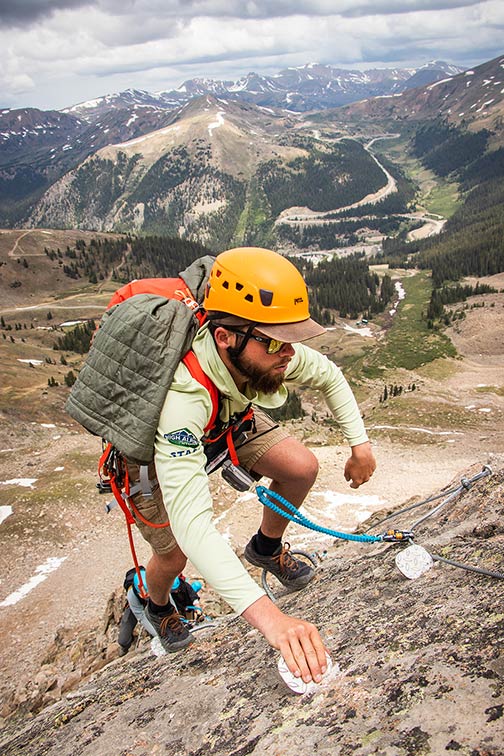
If you want bragging rights to the highest Via Ferrata in North America, this one’s for you. It just may be the closest you can get to a bird’s eye view without sprouting wings. Because of the elevation, this is a strenuous climb. The access hike and climb take place entirely above treeline, between 12,000 and 13,000 feet. The full-day tour climbs 1,200 feet to a 13,000-foot summit. Half-day tours are also available. Reservations required.
< A climber makes his way up the mountain at A-Basin. Photo by Ian Zinner.
IDAHO SPRINGS
A triple treat! This tour combines Via Ferrata with a zip line, 70-foot rappel and a 50-foot free fall. Three-hour tours transport adventurers over Idaho Springs and Chicago Creek.
BUENA VISTA
Run by the same company as Idaho Springs, Buena Vista offers the same thrilling combination of zip line, free fall and rappel against the backdrop of the Collegiate Peaks and Arkansas River.
ROYAL GORGE
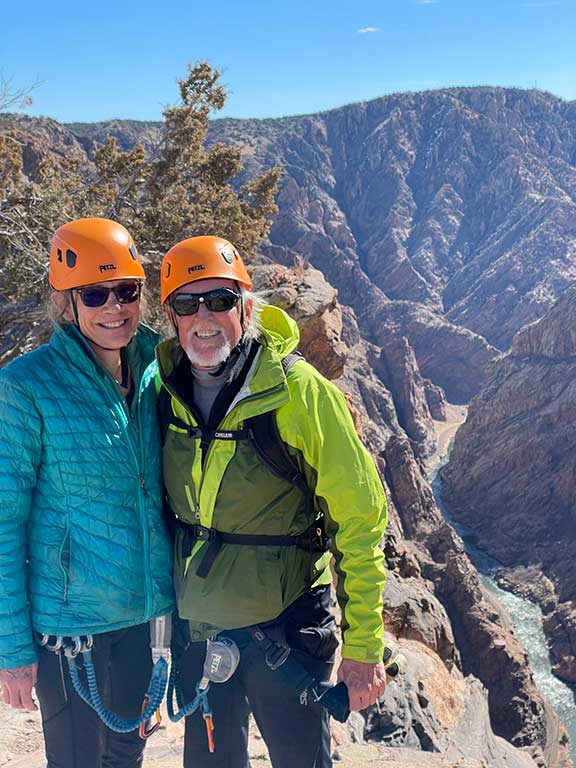
Participants hike down the Grand Traverse, a maintained trail that leads to the start of the 3-hour Revelation Tour or the 5-hour Royal Tour. Prices include general admission to the Royal Gorge Bridge & Park. Shoes, gear, and guide provided.
Writer Joanne Palmer and partner Evan make the summit. >
TELLURIDE
If you have rock-climbing experience and your own gear, the Telluride Via Ferrata is for you. While this course is free and open to the public, the majority of the route is not cabled, which means climbers are not clipped in. First-timers should definitely hire a guide.
OURAY
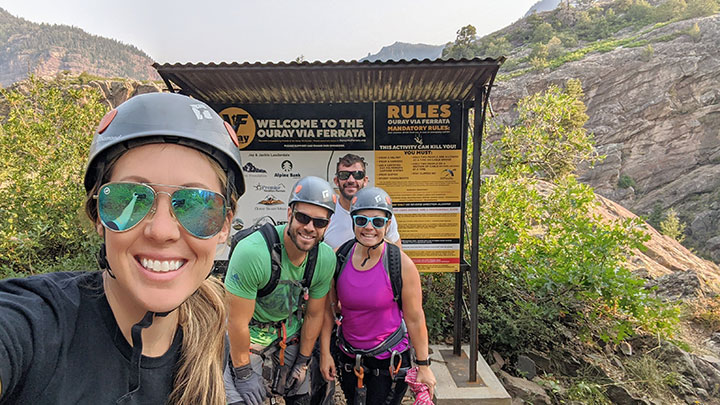
Ouray, the self-proclaimed, “outdoor recreation capital of Colorado,” lives up to its moniker with not one but two Via Ferrata courses in the Uncompahgre Gorge. This summer, visitors can choose between the original route or the new upstream route featuring a helical ladder, which spins the climber in a circle, and “Leap of Faith,” which requires a short jump from one platform to the next. Free and open to the public.
< Grand Valley Power Communications Manager Christmas Wharton and friends prepare to climb one of Ouray’s courses. Photo courtesy of Christmas Wharton.
ESTES PARK
Here you will find two Via Ferratas. The first, easier route is called the Peregrine Ridge. It follows a natural path up the rock with lots of places to hold onto and is a great introductory Via Ferrata. The newer route, The Cloud Ladder, is much steeper. Two sky bridges bring you to the midpoint where the routes meet up and finish together.
Joanne Palmer, who now has her feet back on solid ground, is a freelance writer from Colorado’s Western Slope.

